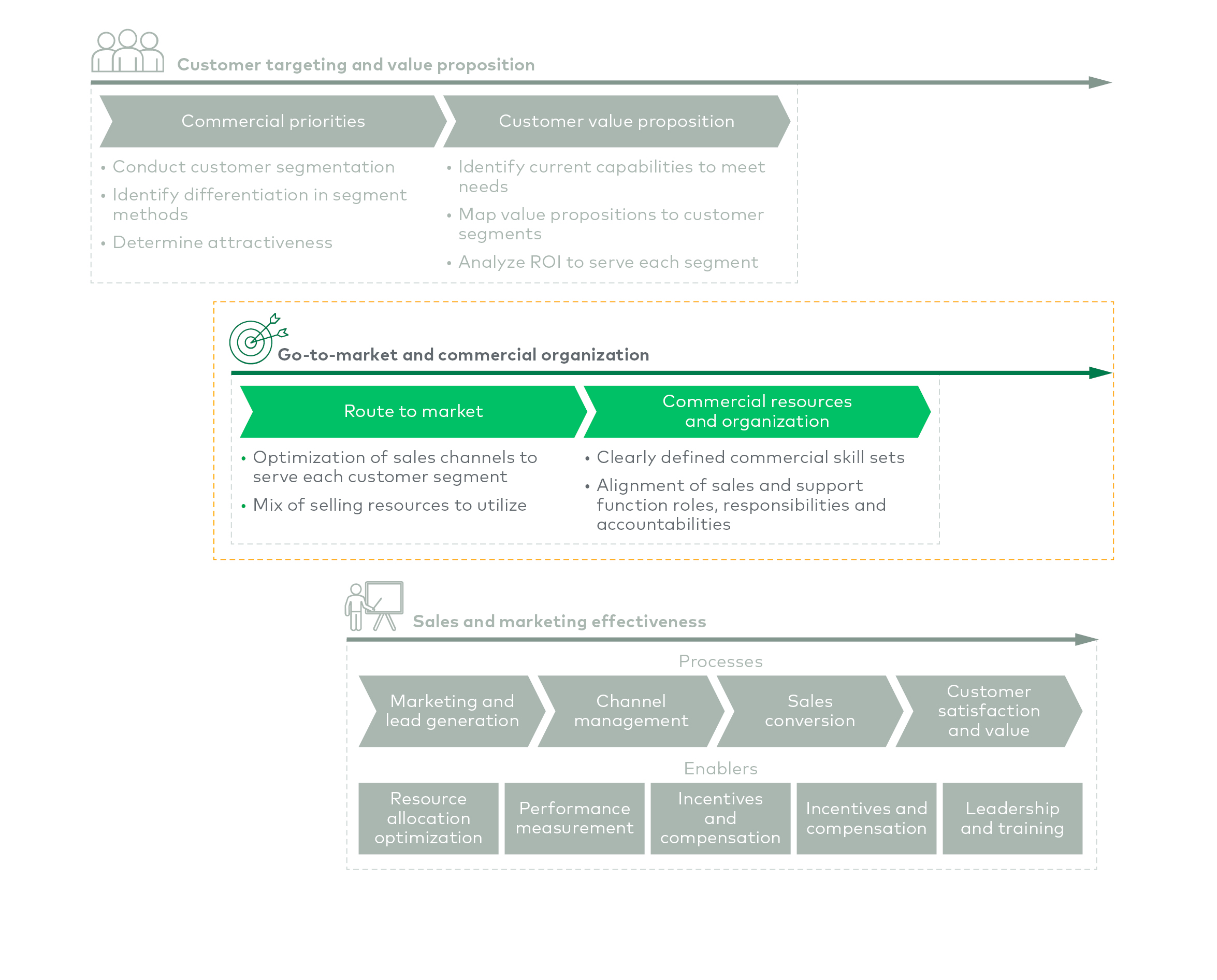Go-to-Market and Commercial Organization
L.E.K. works with clients to define the optimal go-to-market strategy and commercial organization that will deliver against their revenue growth or profit improvement objectives. In both nascent and mature markets, companies need to make complex choices around their go-to-market strategies, considering both direct and indirect models. In nascent markets, the relevant channel infrastructure may not be available, and a business may need to invest independently or in partnerships to build new routes to market. In mature markets, the distribution landscape may be evolving or consolidating. A business needs to carefully select the go-to-market and commercial model that would effectively and efficiently get its products or services to customers while allowing the business to capture the maximum value across the distribution chain.
Overview
Despite investing in significant improvements in product and service offerings, many companies fall short in meeting their growth or cost-efficient targets with their current routes to market. Seeking more effective and efficient ways to sell and service customers can be an important lever for businesses to drive revenue growth or profit improvement. In a number of industries, the channel landscape is evolving, with channels consolidating and becoming more powerful.
Businesses need to adjust or diversify their go-to-market strategy to protect their economics and ensure sustainable distribution in the future. New digital and logistic capabilities allow businesses to directly serve end customers (consumers or businesses), reducing or eliminating the need for intermediaries, thereby both improving the service they provide to their customers and improving their margin economics.
In addition, customer expectations for both product and service quality are increasing, putting more pressure on sales teams and supporting functions. Meeting (or exceeding) end-customer service requirements can be a means for a business to differentiate its position and ensure its long-term success. This may require increasing investment in new capabilities to either serve end customers directly, or complement or support the channels in doing so.
Optimizing a business’s go-to-market model often requires evaluating a range of options, including various indirect and direct alternatives. The starting point is an in-depth understanding of customer product and service requirements, the capabilities of different channels to meet those requirements, and the resulting economics for both the customer and the provider. The definition of the right go-to-market model allows a business to proceed to optimize its own commercial organization and investment by clearly identifying the types of resources that are required to deliver against customer requirements and redeploying the resources against strategic priorities.
How we help
Go-to-Market and Commercial Organization is the second component of our Commercial Excellence framework, specifically focused on defining the optimal route-to-market strategy to its market context and strategic objectives, and aligning a business’s commercial organization and resource deployment accordingly.
L.E.K.’s Commercial Excellence Framework: Go-to-Market and Commercial Organization

L.E.K. helps organizations make the right decisions around their go-to-market strategy, and helps optimize their commercial organizations and resource deployment by:
- Mapping the channel landscape and the distribution chain economics in a sector
- Evaluating existing or new go-to-market options on the basis of strategic, commercial and financial criteria
- Modeling value chain economics for providers, intermediaries and customers under alternative go-to-market scenarios
- Specifically evaluating opportunities for businesses to develop new, often technology-led models to serve their customers directly, reducing or eliminating reliance on intermediaries
- Aligning commercial roles (e.g., sales, account management, product specialists, marketing, technical support, customer service) to deliver against the value proposition to customers
- Reviewing the structure and governance of the commercial functions to ensure strategic alignment and improve cost-efficiency
- Assessing the allocation of commercial resources, including sales, marketing and other supporting functions, against strategic priorities
Your benefits
- A bespoke go-to-market platform to drive future growth, fully aligned to a business’ strategy and the requirements of its customers
- Improved ability to capture an increased share of the value the business is creating for its customers
- Enhanced commercial capabilities across the business to consistently deliver against the customer value proposition
- More sustainable go-to-market strategy for the future, ensuring continued effective distribution to customers and reducing the risk of disintermediation by the channels
- Optimal resource allocation to drive increased return on sales and marketing investment
- Reduction (where appropriate) of the overall sales and marketing cost to release profit to the bottom line








